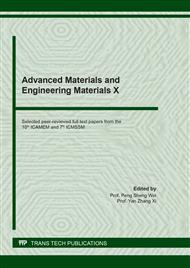p.350
p.358
p.363
p.369
p.375
p.382
p.387
p.392
p.401
An Experimental Study on Electrosparking of Tool Electrode Forced Cooling Based on Micro Heat Pipe Bundle
Abstract:
An electrosparking experiment of ASP30 powder metallurgical steel was carried out through tool electrode forced cooling based on micro heat pipe bundle by using the semiconductor encapsulation mould. Results demonstrate that the micro groove formed among sintered copper fibers based on wick of micro heat pipe and the unique composite structure of the surface chopped morphology can not only increase capillary pressure of the wick, but also strengthen evaporation/condensation process at two ends of the micro heat pipe, and improve cooling effect of micro heat pipe to tool electrode significantly. Compared with traditional electrosparking, electrosparking of tool electrode forced cooling based on micro heat pipe bundle increases the inter-electrode cooling, chip removal and deionization of electrosparking and further lowers tool electrode loss by strengthening heat dissipation of tool electrode. Hence, it can improve stability of electrosparking, increase pulse utilization and increase the processing speed and processing surface quality significantly.
Info:
Periodical:
Pages:
375-381
Citation:
Online since:
November 2021
Authors:
Price:
Сopyright:
© 2021 Trans Tech Publications Ltd. All Rights Reserved
Share:
Citation:


